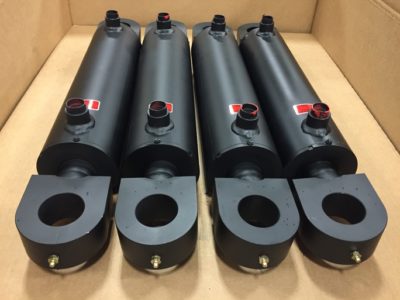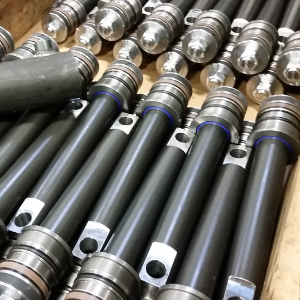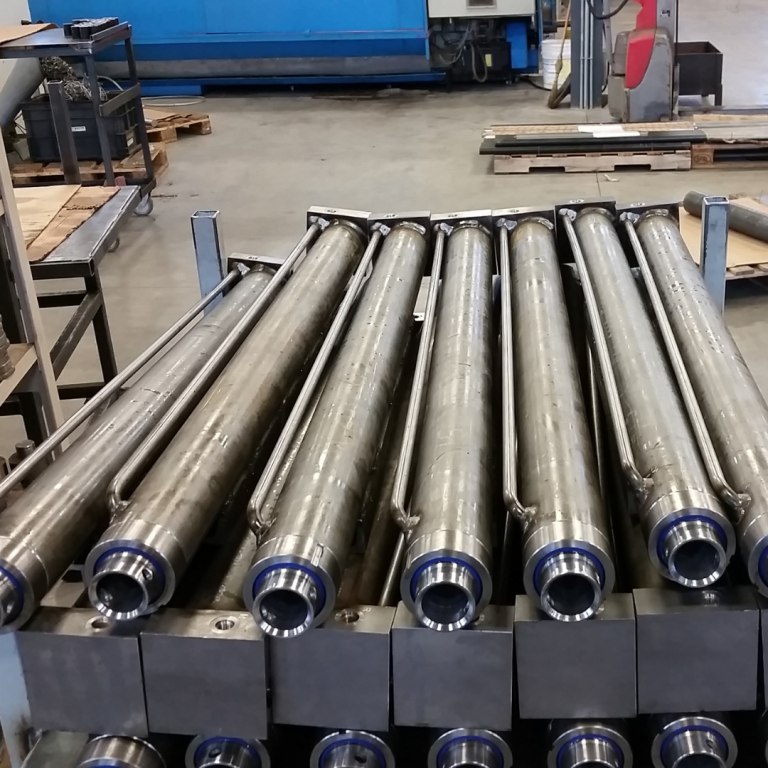
Hydraulic Cylinder Repair Services
Embark on a journey with us as we uncover the essentials of hydraulic cylinder repair services. From honing and resealing to retubing and rod re-chroming, we’ll break down the steps involved in each process. But it doesn’t end there – for every service, we’ll unveil a list of benefits, offering you a holistic understanding of why these repairs matter.
Whether you’re troubleshooting issues or aiming for proactive maintenance, this guide is your go-to for insights into optimizing performance and extending the lifespan of your hydraulic systems. Let’s dive into the world of hydraulic cylinder repair, where every service is a key to unlocking efficiency and reliability.

Table of Contents
Hydraulic Cylinder Inspections
What Does a Hydraulic Cylinder Inspection Consist Of?
Visual Examination
The inspection begins with a visual assessment of the hydraulic cylinder. Technicians look for visible signs of damage, wear, or corrosion on the external surfaces. This step helps identify issues that may require further investigation.
Seal Integrity Check
Seals play a critical role in preventing leaks and ensuring the efficient operation of hydraulic cylinders. Inspectors examine the seals for signs of wear, damage, or degradation. Any issues with the seals are noted for further action.
Internal Component Inspection
Depending on the type of hydraulic cylinder, technicians may disassemble the cylinder to inspect internal components. This includes examining the piston, rod, and other internal parts for wear, scoring, or other abnormalities.
Fluid Analysis
Hydraulic fluid is analyzed for contamination, degradation, and proper levels. Fluid samples may be taken to assess the cleanliness and quality of the hydraulic fluid, as contamination can lead to performance issues and component damage.
Alignment Check
Proper alignment is essential for the optimal functioning of hydraulic cylinders. Technicians check for any misalignment or uneven wear that could affect the performance of the cylinder.
Functional Testing
After reassembly, functional tests are conducted to ensure that the hydraulic cylinder operates as intended. This may involve testing the cylinder under load to simulate real-world operating conditions.
Benefits of Having Cylinders Inspected: Safeguarding Performance and Longevity
Early Issue Detection
Hydraulic cylinder inspections allow for the early detection of potential problems. Identifying issues in their early stages enables timely intervention, preventing more extensive damage and costly repairs.
Preventive Maintenance
Regular inspections form the basis of a preventive maintenance strategy. Addressing minor issues before they escalate helps extend the lifespan of hydraulic cylinders and reduces the risk of unexpected failures.
Optimized Performance
Inspections contribute to the optimized performance of hydraulic cylinders. By addressing issues such as misalignment, seal leaks, or fluid contamination, the overall efficiency of the hydraulic system is enhanced.
Cost Savings
Investing in routine inspections is a cost-effective approach. The cost of preventive maintenance and timely repairs is typically lower than the expenses associated with extensive repairs or replacements resulting from neglected issues.
Increased Safety
Well-maintained hydraulic cylinders contribute to a safer working environment. Regular inspections help identify and rectify potential safety hazards, reducing the risk of accidents and injuries.
Hydraulic Cylinder Reseal

Hydraulic systems are the backbone of many industrial operations, and the performance of hydraulic cylinders is critical to their functionality. Over time, wear and tear can take a toll on these essential components, leading to issues that may necessitate a hydraulic cylinder reseal. Recognizing the signs that your hydraulic cylinders need attention is crucial in maintaining optimal system performance.
When to Have Your Hydraulic Cylinders Resealed: Common Issues
Fluid Leaks
One of the most apparent indicators is the presence of hydraulic fluid leaks around the cylinder. If you notice puddles or a gradual decline in fluid levels, it’s a clear sign that the seals are compromised and a reseal may be necessary.
Inconsistent Performance
If your hydraulic system is exhibiting erratic or uneven movements, it could be a result of seal degradation within the cylinder. Inconsistent performance is a red flag that warrants a closer inspection.
Sluggish Operation
A decrease in the speed or efficiency of your hydraulic cylinders is often a symptom of internal leaks or worn-out seals. Resealing can restore the smooth and efficient operation of the cylinders.
Excessive Noise
Unusual sounds during hydraulic system operation, such as knocking or banging, may indicate issues with the seals. A hydraulic cylinder reseal can address these noise-related issues.
Visual Wear and Tear
Regular visual inspections are essential. If you observe visible damage, scoring, or wear on the cylinder components, it’s a strong indication that a reseal may be needed to prevent further deterioration.
Benefits of Having Your Cylinders Resealed: Investing in Longevity and Efficiency
Opting for hydraulic cylinder reseal services offers a range of benefits that go beyond merely addressing existing issues. Here are some compelling reasons to consider having your hydraulic cylinders professionally resealed:
Extended Lifespan
A well-executed reseal can significantly extend the lifespan of your hydraulic cylinders, providing a cost-effective alternative to premature replacements.
Improved Performance
Resealing not only fixes current issues but also enhances the overall performance of the hydraulic system. This results in smoother operations, increased efficiency, and better productivity.
Cost Savings
Investing in resealing is often more cost-effective than purchasing new cylinders. It allows businesses to maximize the value of their existing equipment without incurring the expense of complete replacements.
Reduced Downtime
Prompt resealing of hydraulic cylinders minimizes downtime. It ensures that your equipment stays operational, preventing disruptions to your workflow and production schedules.
Preventive Maintenance
Resealing is a proactive measure that prevents potential issues from escalating. It helps identify and address issues in their early stages, reducing the risk of extensive damage to the hydraulic system.
Hydraulic Cylinder Honing
Hydraulic cylinder honing is a specialized machining process designed to achieve a high level of precision and surface finish on the inner bore of hydraulic cylinders. This meticulous technique plays a crucial role in maintaining the optimal functionality and longevity of hydraulic systems.
The Hydraulic Cylinder Honing Process
Preparation
Before honing begins, the hydraulic cylinder is disassembled, and the piston and other internal components are removed. This allows access to the inner bore, which is the focus of the honing process.
Initial Inspection
The inner surface of the hydraulic cylinder bore is closely inspected for any imperfections, such as scratches, scoring, or irregularities. This assessment helps determine the extent of honing required.
Honing Tool Selection
The honing tool is carefully selected based on the specific requirements of the hydraulic cylinder. Various honing tools, such as abrasive stones or diamond-plated tools, may be chosen depending on the material of the cylinder and the desired surface finish.
The Hydraulic Cylinder Honing Process
The honing tool is inserted into the hydraulic cylinder, and the honing process begins. The tool oscillates or rotates while moving in and out of the cylinder bore. This controlled movement helps remove material evenly, resulting in a smooth and precisely finished inner surface.
Achieving the Desired Surface Finish
Hydraulic cylinder honing aims to achieve a specific surface finish, measured in terms of roughness. The honing process helps eliminate imperfections, creating a surface that promotes efficient sealing and reduces friction between the cylinder and piston.
Final Inspection
Once honing is complete, a final inspection is conducted to ensure that the desired surface finish has been achieved. This step is critical in guaranteeing the effectiveness of the honing process in enhancing the hydraulic cylinder’s performance.
Benefits of Hydraulic Cylinder Honing
Improved Seal Performance
Honing creates a smoother surface, reducing the likelihood of leaks and enhancing the effectiveness of seals within the hydraulic cylinder.
Reduced Friction
The honing process reduces surface irregularities, minimizing friction between the cylinder and piston. This contributes to smoother operation and increased overall efficiency.
Extended Component Lifespan
By eliminating imperfections and reducing wear, hydraulic cylinder honing helps extend the lifespan of the cylinder. This is particularly beneficial in high-performance and heavy-duty hydraulic systems.
Enhanced Performance
Honing contributes to the optimal performance of hydraulic cylinders by ensuring precise tolerances and a high-quality surface finish. This is crucial for applications where precision and reliability are paramount.
Cost-Effective Maintenance
Hydraulic cylinder honing is a cost-effective maintenance technique compared to the expense of replacing cylinders. It allows businesses to refurbish and optimize existing components, promoting sustainability and efficiency.
Retubing Hydraulic Cylinders: Breathing New Life into Essential Components
Retubing is a specialized process in hydraulic cylinder maintenance that involves replacing the tubing or barrel of a hydraulic cylinder while retaining the original end fittings and other components. This procedure is employed when the existing tubing is damaged, worn, or corroded, compromising the overall integrity and functionality of the hydraulic cylinder.
Assessment and Disassembly
The hydraulic cylinder undergoes a thorough assessment to determine the extent of tube damage and the feasibility of retubing. If retubing is deemed necessary, the cylinder is disassembled to access the tubing
Tube Removal
The damaged or compromised tubing is carefully removed from the hydraulic cylinder. This step may involve cutting or machining the tube to facilitate its extraction.
End Fitting Inspection
The end fittings, including the piston, rod, and other components, are inspected for wear, damage, or any issues that might require attention. These components are typically retained for reuse in the retubing process.
New Tubing Installation
A new tubing, often made of high-quality materials compatible with the hydraulic system’s requirements, is precision-fitted into the hydraulic cylinder. The tube is secured in place, and meticulous attention is given to proper alignment.
Reassembly
Once the new tubing is securely in place, the hydraulic cylinder is reassembled. This involves reconnecting the piston, rod, and other components, ensuring that the retubed cylinder is structurally sound.
Testing and Quality Assurance
Lorem ipsum dolor sit amet, consectetur adipiscing elit. Ut elit tellus, luctus nec ullamcorper mattis, pulvinar dapibus leo.
Benefits of Hydraulic Cylinder Retubing
Cost-Effective Maintenance
Retubing is often a cost-effective alternative to replacing the entire hydraulic cylinder. It allows businesses to extend the life of their hydraulic systems without incurring the expense of new components.
Quick Turnaround
Compared to the time required for manufacturing and delivering new hydraulic cylinders, the retubing process generally has a quicker turnaround. This is crucial for minimizing downtime and maintaining operational efficiency.
Reuse of Components
Retubing allows for the retention and reuse of critical components such as end fittings, pistons, and rods. This not only reduces costs but also ensures consistency in performance.
Sustainability
By refurbishing and retubing hydraulic cylinders, businesses contribute to sustainable practices by reducing the need for new material production and minimizing waste.
Customization
During the retubing process, businesses have the opportunity to choose materials and specifications that align with their specific hydraulic system requirements, contributing to enhanced performance.
Rod Rechroming: Restoring Luster and Functionality to Hydraulic Cylinder Rods
Rod re-chroming is a specialized process in hydraulic cylinder maintenance that involves refurbishing the chrome-plated rod of a hydraulic cylinder. The chrome plating on the rod serves several crucial purposes, including providing corrosion resistance, reducing friction, and enhancing the overall durability and longevity of the hydraulic system.

The Rod Rechroming Process
Assessment
The hydraulic cylinder undergoes a comprehensive assessment to evaluate the condition of the chrome-plated rod. This includes checking for wear, corrosion, pitting, or any other damage that may compromise the rod’s functionality.
Rod Removal
If rod rechroming is deemed necessary, the chrome-plated rod is carefully removed from the hydraulic cylinder. This step may involve disassembling the cylinder to access and extract the rod.
Stripping and Cleaning
The existing chrome plating is stripped from the rod to expose the base metal. The rod is then thoroughly cleaned to remove any contaminants or residue that may affect the quality of the new chrome plating.
Surface Preparation
The rod’s surface is prepared for rechroming, which may involve polishing or machining to achieve a smooth and uniform surface. This step is crucial for ensuring the adhesion and quality of the new chrome plating.
Chrome Plating Application
The prepared rod is immersed in a bath containing chromium solution, and an electroplating process is employed to deposit a new layer of chrome onto the rod’s surface. This chrome layer provides the rod with the desired properties, including corrosion resistance and reduced friction.
Quality Inspection
Once the rechroming process is complete, the rod undergoes a thorough quality inspection. This includes checking the thickness and uniformity of the chrome layer, as well as ensuring that the rod meets the required specifications for diameter and surface finish.
Reassembly
After passing the quality inspection, the rechromed rod is carefully reassembled into the hydraulic cylinder. This involves reconnecting the rod with other components such as the piston, seals, and end fittings.
Testing
The hydraulic cylinder, now equipped with the rechromed rod, undergoes various tests to ensure that it meets or exceeds the required performance standards. This may involve functional tests, pressure tests, and checks for proper alignment.
Benefits of Rod Rechroming:
Corrosion Resistance
Chrome plating provides a protective layer that enhances the rod’s resistance to corrosion, a crucial factor in maintaining the longevity of hydraulic cylinders, especially in challenging environments.
Reduced Friction
The smooth and hard surface of chrome-plated rods reduces friction between the rod and cylinder components, contributing to improved efficiency and performance of the hydraulic system.
Extended Lifespan
Rod rechroming helps extend the lifespan of hydraulic cylinders by refurbishing and reinforcing the rod, reducing the need for premature replacements.
Cost-Effective Maintenance
Rechroming is often a cost-effective alternative to purchasing new hydraulic cylinders. It allows businesses to refurbish and optimize existing components, providing value and cost savings.
Enhanced Performance
The restored chrome plating ensures that the hydraulic cylinder operates with optimal efficiency, contributing to the overall performance of the hydraulic system.
Conclusion: Elevating Hydraulic Performance
As we conclude our exploration of hydraulic cylinder repair services, we’ve unveiled the intricacies of honing, resealing, retubing, and rod rechroming. Each process plays a vital role in maintaining the health of hydraulic systems.
The benefits extend far beyond repairs – they’re pathways to cost savings, extended lifespan, and heightened performance. By understanding these services and their advantages, you’re empowered to make informed decisions, ensuring your hydraulic systems operate at their best.
In the dynamic world of hydraulics, where precision meets power, let this guide serve as your compass. Whether troubleshooting or proactively maintaining, you now hold the keys to elevating the efficiency and reliability of your hydraulic cylinders. Here’s to seamless operations and optimized performance in your hydraulic endeavors!


